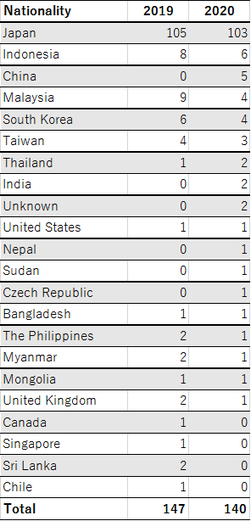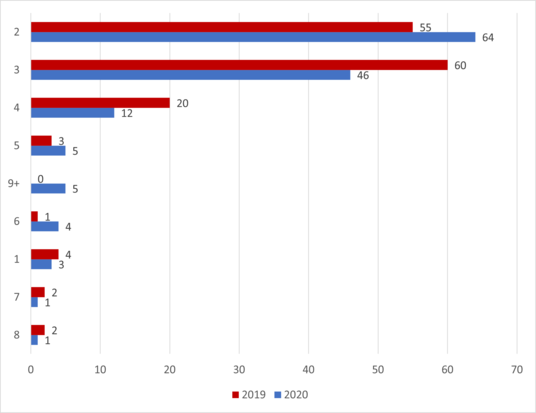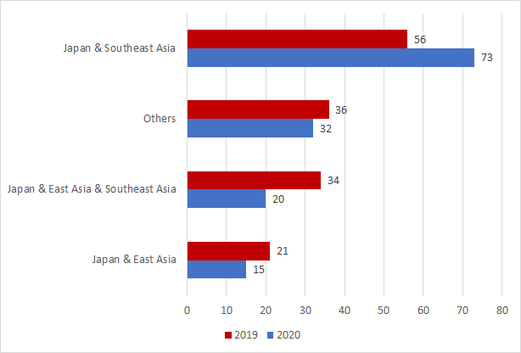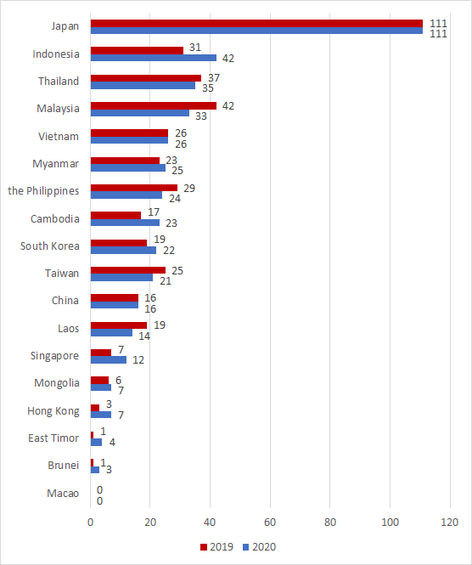Selection Committee Chair Prof. Shigeto Sonoda
Outline of Fiscal 2020 International Grant Program “Cultivating Empathy Through Learning from Our Neighbors: Practitioners’ Exchange on Common Issues in Asia”
This is the second time for me to provide commentary on selection results, after I did so for the selection in fiscal 2019.
In fiscal 2019, the prioritized area (Area A) "Multicultural Inclusion in Communities" was set and applicants were required to choose either Area A or the other field, Open Field (Area B). This fiscal year, the prioritized area (Area A) was abolished. This is mainly because there was overlapping goals and details between Area A and the special subject program newly included in fiscal 2019 "Migrants and Japanese Society". Additionally, the previous fiscal year's scheme caused some confusion: some applied to the Open Field (Area B) although the features of their proposal corresponded to the prioritized area (Area A), and vice versa. The abolition of the prioritized area allows applicants to freely choose common issues in Asia and envisage exchange and the selection committee is better able to examine applications straightforwardly.
There are no changes in the five grant policies (1. Great significance for society, 2. Anticipating internal and external issues, 3. Future-oriented, 4. Sustainable and developable, and 5. Expected to have a ripple effect) and the four elements that the foundation adopts during the selection of projects.
The overall budget remains the same, 70,00,000 yen (https://www.toyotafound.or.jp/international/2020/).
Overview of the Situation and Details of Application
This year, the open call for proposals began in April as usual. At first, we feared that the number of applications would drop drastically because of the COVID-19 pandemic. We expected that applicants would have difficulty designing mutual exchange while moving across borders was limited due to the pandemic. However, we received 140 applications, which was a small decrease from 147 in fiscal 2019. That is, there only appeared to be a minimal impact from the pandemic.
In the previous fiscal year, the foundation newly requested that applicants have their main residence in Japan as a condition for application. This greatly affected the proposition of the nationality of applicants. A bit more than one third of all applicants were Japanese prior to the change. In the previous fiscal year, Japanese applicants exceeded 70%, and the number of applicants with Malay, Indonesian or Philippine nationality decreased significantly. The distribution of the nationalities of applicants is similar to that of the previous fiscal year (see Table 1). This year, there were Chinese applicants, unlike the previous fiscal year, but the number of applicants holding Southeast Asian nationalities dropped again. Despite these minor changes, the composition of applicants did not change very much: more than 70% of the applicants were Japanese this fiscal year.
Table 1: Distribution of the nationalities of applicants for fiscal 2019, 2020 and 2021

Judged by the number of targeted countries/regions (see Fig. 1) and the combinations (see Fig. 2), more applicants combined Japan and one of the Southeastern countries while less applicants combined three countries or more covering Japan, East Asia, and Southeast Asia, compared with the previous year. Many of the applications focused on feasibility although the number of large-scale proposals covering nine countries or more increased from zero to five. Additionally, more applications focused on Japan and Southeast Asia while less targeted Japan and East Asia.
This fiscal year again, three applications only targeted one country as shown in Figure 1. The committee excluded them because they did not consider transnationality, one of the four aforesaid elements.
Fig. 1: Number of targeted countries/regions that were stated in applications in 2019 and 2020
(Excluding countries/regions outside East and Southeast Asia)

Fig. 2: Numbers of targeted countries/regions that were stated in application forms in 2019, 2020 and 2021
(Excluding countries/regions outside East and Southeast Asia)

Figure 3 shows the distribution of targeted countries/regions stated in applications. The number of applications targeting Japan was 111, similar to the previous fiscal year, which reflects the large number of applications from Japanese applicants. Looking closely at the proposed projects targeting both Japan and Southeast Asia, more proposals targeted Indonesia while less focused on Malaysia: there were slight changes within the applications involving Southeast Asia.
Fig. 3: The number of targeted countries/regions that were stated in applications for 2019 and 2020
(Excluding countries/regions outside East and Southeast Asia)

Applications were found to describe diverse projects, which contained many different factors, such as multicultural coexistence, gender, environmental preservation, sustainability, conservation of cultural properties, tourism, education, poverty and disparities, disaster prevention, food safety, resource management, community construction, and aging.
Selection process and results
The selection committee was made up of four members including the committee chair. Two of them have continued in their positions from the previous fiscal year, while the remaining two were newly appointed. The selection process was almost the same as in the previous fiscal year.
First, three program officers (POs) from the Toyota Foundation closely reviewed 140 applications individually. They eliminated those applications which did not satisfy four elements before they asked each committee member to inspect the remaining applications.
The four committee members read the applications carefully, and each recommended ten projects as planned based on the number of selected projects in previous years. Each member gave a weight on a smaller number of the projects that he or she strongly recommended and added their own personal comments. If a member had any question about the proposal or expected difficulties in the implementation of the proposal, he or she informed the POs who communicated the questions/concerns to the applicants and asked for replies.
At the end of the selection process, the results of the reviews by the four committee members were summarized, and a selection committee meeting was held. They discussed the 22 applications that at least one of the four members had recommended. Each member explained why he or she recommended or did not recommend the project. They discussed any disagreements and adjusted differences in opinions. They chose candidates tentatively in light of the responses from applicants. Then, they made the final decision, having considered the balance between themes and among targeted countries or regions, budget distribution and others.
Nine projects were selected, the same as in the previous fiscal year. The selection rate was a low 6%, as usual.
The projects selected for this fiscal year have the following characteristics.
Firstly, many of the projects target a small number of countries combining Japan and Southeast Asia. This reflects the general trend found in most applications. As explained below, Ms. Yuko Shirai proposed a project targeting Laos, Thailand, and Myanmar, and Mr. Ken Ito focused on the Philippines, Thailand, and Indonesia. These two applicants target Southeast Asia, excluding Japan. All other projects employ a combination of Japan and Southeast Asia and/or a country/countries other than East Asia. In other words, in the end, no projects targeting East Asia were selected even though some of the 22 final candidate projects did target East Asia. In fiscal 2019, two projects targeting Japan, East Asia, and Southeast Asia were selected. The projects selected this fiscal year do not include that combination of areas.
Secondly, the selection results included multiple projects addressing the current pandemic. Mr. Dipesh Kharel proposed producing an ethnographic film featuring the students unable to travel between Japan and their home countries, Vietnam or Nepal, due to the pandemic. The project proposed by Ms. Kanako Kusanagi aims to review education in Japan, Indonesia, and Malaysia in the face of the COVID-19 pandemic, consider what an ideal form of global citizenship education would be as desired in children's education, and give concrete suggestions. Ms. Eri Yoshimura tries to support immigrants during the pandemic through the training of young human resources, linking Thailand with Japan. All of these proposals were based on projects that had been carried out, assumed the use of the existing networks, and sought transborder solidarity during the pandemic.
Thirdly, there is the tendency towards a higher selection rate for applicants who had done projects with grants from the Toyota Foundation. Of the 140 applications, 21 proposals were made by those who had received grants from the foundation in the past. Three of the 21 proposals were selected: the rate of selection is 14.3% On the other hand, six proposals (5%) were selected from 119 applications made by those who had not received grants from the foundation: there is a great difference between the two groups.
This fiscal year, the selection results did not include any projects relating to environmental protection or sustainability when previously such projects had been selected every time. It is a shame because environmental preservation is still important, even during the pandemic.
Introducing Adopted Projects
The following introduces two projects that received relatively better evaluation among the adopted projec
| Yuko Shirai, "Sustainable Cross-Border Community Development and Management in the East-West Economic Corridor in the time of COVID-19" |
| Countries: Laos, Thailand, and Myanmar |
| Term: 2 years |
| Amount: 9,000,000 yen |
The project aims to nurture cross-border capacity through mutual learning in two communities at the border between Laos and Thailand and the border between Thailand and Myanmar, focusing on the East-West Economic Corridor between Laos, Thailand, and Myanmar. It presents varied ideas that allow community members to understand problems caused by borders and learn to solve them. The project is designed to involve officials of local and central governments as well as local researchers. It stems from discussion on experience operating past projects.
The proposal is found to be timely because the world has had to close borders because of the pandemic, and people beyond the local residents can probably learn something. It would be a better project if it pursued the impact on society beyond academic disciplines, such as practical regional development.
| Ken Ito, "Accelerating Cross-Border and Cross-Sector Collaboration Through Social Investment" |
| Countries: Philippines, Indonesia, and Thailand |
| Term: 2 years |
| Amount: 9,000,000 yen |
The project aims to invite ten policy makers/third sector managers to a Policy Leadership Lab led by Asian Venture Philanthropy Network (AVPN) from Philippines, Indonesia, and Thailand and activate social investment in such regions through activities. The well-formulated project was evaluated highly, being very forward-looking. It does not try to develop social investors directly but encourage important policy leaders to better understand and support social investment as an indirect approach. The applicant has a satisfactory track record, including involvement in joint projects in progress with The Rockefeller Foundation and the BMW Foundation Herbert Quandt.
Strong outcomes are possible if they make full use of the internal and peripheral networks of AVPN and try hard to involve diverse sectors.
Applications strongly appealed to the selection committee if applicants understood the foundation's missions and characteristics and the goals of the International Grant Program, even if the applicants have not received the Toyota Foundation’s grant in the past, if for instance, the applicants had participated in explanatory meetings and detailed consultations with POs. Applicants for the next fiscal year are encouraged to take this point into account.
Conclusion
The number of applications did not decrease as expected even as the world faces the pandemic. It is because a certain amount of projects had been planned, and existing social capital was used. The pandemic will affect the implementation of selected projects directly or indirectly. Therefore, the representatives of the selected project should operate projects carefully.
The prolonged pandemic will limit opportunities for encounters. It will exhaust social capital, and worse, prevent new social capital from being generated. If this is the case, new, challenging projects will not be envisioned. It is possible to detect issues shared by Asian countries and carry out specific actions to solve these issues while traveling and conducting activities. Therefore, the current situation seems to completely hinder the future growth and development of the International Grant Program, because of the restrictions on free travel.
Hopefully, the coronavirus pandemic will end soon.
